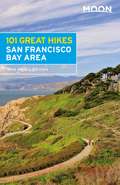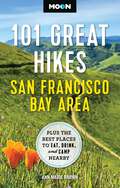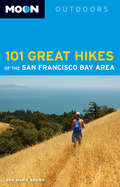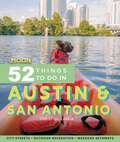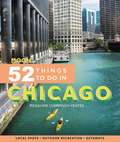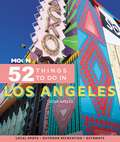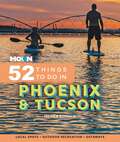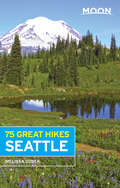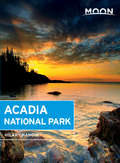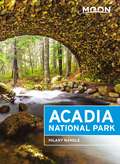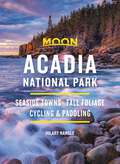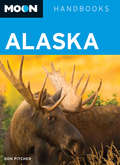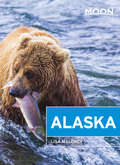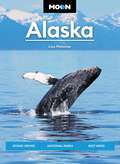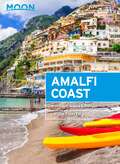- Table View
- List View
Moon Normandy & Brittany: With Mont-Saint-Michel (Travel Guide)
by Chris NewensDramatic coastline, charming villages, unforgettable history, and distinct local culture: See a different side of France with Moon Normandy & BrittanyFlexible itineraries for 1 to 5 days in Normandy and Brittany that can be combined into a 2-week trip, plus suggestions for easy side tripsStrategic advice for foodies, art lovers, history buffs, outdoor adventurers, and moreMust-see highlights and unique experiences: Hike the dramatic chalk cliffs of Étretat or stroll the gardens that inspired Monet's Water Lilies. Cycle the rolling hills and endless backroads to small villages and sip cider with locals at a Celtic Festoù-noz pulsing with traditional dance and music. Pay your respects at the D-Day beaches and monuments and learn about the largest military landing in history. Admire the spectacular monastery rising above the tidal plains of Mont Saint Michel and enjoy fresh seafood in Saint-MaloHonest advice on where to stay, how to get around, and where to find the best regional cuisine, from creamy cheeses in Normandy to Breton galettes and ciderLocal perspective from British expat and local expert Chris NewensFull-color photos and detailed maps throughoutBackground information on the landscape, history, and cultural customs of each regionHandy tools such as a French phrasebook and tips for traveling with children or as a seniorWith Moon Normandy & Brittany's practical tips and local insight on the best things to do and see, you can plan your trip your way.Exploring more of France? Try Moon Paris Walks. Craving the beach? Check out Moon Amalfi Coast.
Moon 101 Great Hikes San Francisco Bay Area (Moon Outdoors)
by Ann Marie BrownYour Adventure Starts Here with Moon Travel Guides!Are you at home in the golden hills of Berkeley, or the lush redwood forests of Marin? Explore the paradise just outside your door with Moon 101 Great Hikes of the San Francisco Bay Area. Inside you'll find:A Hike for Everyone: Hikes range from short, flat routes suitable for families to daylong, steep treks for more ambitious hikers, with options to extend or shorten the hikes. All hikes are rated for difficulty and marked for features such as dog-friendly or wheelchair accessibleExplore the Trails: Highlights like waterfalls, beaches, historic sites, wildlife, and wildflowers are noted on each hikeMaps and Directions: Explore with easy-to-use maps and point-by-point navigation for each trail, and including driving directions to each trailhead with GPS coordinates and public transit options when availableTop Hikes: Lists like "Best Redwood Forests," "Best Short Backpacking Trips," and "Best Bird-Watching" will help you choose where to hike in Napa, Sonoma, Marin, the East Bay, San Francisco, the Peninsula, and the South BayTrusted Advice: Anne Marie Brown shares the experience and knowledge she's gained from hiking, biking, and camping in and around the Bay Area more than 150 days a yearTips and Tools: Find essentials like health, safety, and trail etiquette, background information on the landscape and history of the trails, and volunteer opportunities so you can help keep the trails as beautiful as you found themWhether you're a veteran or a first-time hiker, Moon's comprehensive coverage and trusted advice will have you ready to lace up your hiking boots and head out on your next adventure.Looking for trails beyond the Bay Area? Try Moon Northern California Hiking or Moon California Hiking. Ready for an overnight outdoor adventure? Check out Moon Northern California Camping or Moon California Camping.
Moon 101 Great Hikes San Francisco Bay Area: Plus the Best Places to Eat, Drink, and Camp Nearby (Moon Hiking Travel Guide)
by Ann Marie Brown Moon Travel GuidesLocal author Ann Marie Brown reveals the best Bay Area hikes, from the wildflowers of the South Bay to the redwood forests of Marin. Get a breath of fresh air with Moon 101 Great Hikes San Francisco Bay Area. Inside you'll find:Hikes for everyone: Hikes range from short, flat routes suitable for families to day-long, steep treks for more ambitious hikers, with flexible options to shorten or extend many routes Explore the trails: All hikes are marked with difficulty ratings, features (such as dog-friendly or wheelchair-accessible), and highlights like beaches, historic sites, wildlife, and wildflowers Maps and directions: Follow easy-to-use maps and point-by-point directions for each trail, including driving directions to trailheads, GPS coordinates, and public transit options when available Top hikes: Strategic lists of the best waterfalls, summit vistas, hikes by season, and more to help you choose the right hike in Napa, Sonoma, Marin, the East Bay, San Francisco, the Peninsula, and the South Bay Trusted advice: Outdoors expert Ann Marie Brown shares the experience and knowledge she's gained from hiking, biking, and camping in and around the Bay Area for more than 150 days a year Tips and tools: Essential information about health and safety, trail etiquette, the landscape, and more, plus lists of the best campgrounds in each region Whether you're an outdoors expert or a first-time hiker, Moon's practical tips and comprehensive coverage will have you ready to lace up your boots and hit the trails. Looking for hikes beyond the Bay? Try Moon Northern California Hiking or Moon California Hiking. Ready for an overnight adventure? Check out Moon Northern California Camping or Moon California Camping.About Moon Travel Guides: Moon was founded in 1973 to empower independent, active, and conscious travel. We prioritize local businesses, outdoor recreation, and traveling strategically and sustainably. Moon Travel Guides are written by local, expert authors with great stories to tell—and they can't wait to share their favorite places with you. For more inspiration, follow @moonguides on social media.
Moon 101 Great Hikes of the San Francisco Bay Area
by Ann Marie BrownAvid hiker and experienced travel writer Ann Marie Brown knows the best places to hike in the San Francisco Bay Area, from ocean-front and mountain trails to scenic walks through Wine Country. This fifth edition of Moon 101 Great Hikes of the San Francisco Bay Area includes new hikes, as well as a handy trail map for Marsh and South Pasture Loop. With helpful icons indicating access to historic sites, trails that are appropriate for children, wheelchair-accessible trails, and trailheads that can be accessed via public transportation, this guide is perfect for inexperienced and expert hikers alike.Complete with difficulty levels from 1 to 5, Moon 101 Great Hikes of the San Francisco Bay Area provides hikers with first-rate expert advice and all the necessary tools to head outdoors.This ebook and its features are best experienced on iOS or Android devices and the Kindle Fire.
Moon 52 Things to Do in Austin & San Antonio: Local Spots, Outdoor Recreation, Getaways
by Christina GarciaFrom that taco truck you haven&’t tried yet to the Hill Country getaway you keep meaning to plan, experience something new right here at home with Moon 52 Things to Do in Austin & San Antonio. Inside you&’ll find:Cool things to do in and around the cities: Get to know more about East Austin&’s Black and brown roots, look for murals by local artists, and have old-fashioned fun at a drive-in theater. Learn about native Texas plants on a hike, cool off at a nearby swimming hole, or sample authentic sotol in the desert. Grab a cocktail on Rainey Street, listen to live jazz, or learn how to two-step from an expert. People-watch in San Antonio&’s hip Pearl neighborhood, bike the Mission Trail, and feast on tacosDay trips and weekend getaways: Sample and sip on the Hill Country Wine Trail or dig in to a plate of barbecue in Lockhart. Cool off in Wimberley's Blue Hole, float the river in New Braunfels, or creep through the caves at Longhorn Cavern State ParkExperiences broken down by category: Find ideas for each season, activities with kids, outdoor adventures, late-night music, arts and culture, scenic drives, and moreA local's advice: Whether it&’s an art gallery or a historic landmark, local author Christina Garcia knows the ins and outs of Austin and San AntonioInspirational full-color photos throughout Easy-to-scan planning tips: Addresses, time allotment, and tips for avoiding the crowds at popular attractionsWhat are you doing this weekend? Try something new with Moon 52 Things to Do in Austin & San Antonio.About Moon Travel Guides: Moon was founded in 1973 to empower independent, active, and conscious travel. We prioritize local businesses, outdoor recreation, and traveling strategically and sustainably. Moon Travel Guides are written by local, expert authors with great stories to tell—and they can't wait to share their favorite places with you.For more inspiration, follow @moonguides on social media.
Moon 52 Things to Do in Boston: Local Spots, Outdoor Recreation, Getaways
by Cameron SperanceFrom that South End gallery you haven&’t visited yet to the mountain getaway you keep meaning to plan, experience something new right here at home with Moon 52 Things to Do in Boston.Cool things to do in and around the city: Stroll over to the Rose Kennedy Greenway or rent a kayak on the Charles. Dig in to dim sum in Chinatown and get lost in the stacks at Boston Public Library. Immerse yourself in local history on the Black Heritage Trail and get to know Cambridge beyond Harvard Yard. Pay respect to Boston&’s sports dynasties or take in a drag show at JacquesDay trips and weekend getaways: Rejuvenate on a weekend in the Berkshires, discover America&’s LGBTQ playground in Provincetown, get your feet wet at the beach, or explore a new art exhibit at Mass MoCAExperiences broken down by category: Find ideas for each season, activities for kids, outdoor adventures, arts and culture, scenic drives, and moreA local's advice: Whether it&’s a worthwhile stop on the Freedom Trail or a neighborhood food hall, local author Cameron Sperance knows the ins and outs of BostonInspirational full-color photos throughout Easy-to-scan planning tips: Addresses, time allotment, T stops, and tips for avoiding the crowds if you're heading to a popular attractionWhat are you doing this weekend? Try something new with Moon 52 Things to Do in Boston. About Moon Travel Guides: Moon was founded in 1973 to empower independent, active, and conscious travel. We prioritize local businesses, outdoor recreation, and traveling strategically and sustainably. Moon Travel Guides are written by local, expert authors with great stories to tell—and they can't wait to share their favorite places with you.For more inspiration, follow @moonguides on social media.
Moon 52 Things to Do in Chicago: Local Spots, Outdoor Recreation, Getaways
by Rosalind Cummings-YeatesFrom that gallery in River North you haven&’t visited yet to the lakeside weekend you keep meaning to plan, experience something new right here at home with Moon 52 Things to Do in Chicago.Cool things to do in and around the city: Wander over to the zodiac sculptures in Chinatown Square, or soak up some music and history at the Black Ensemble Theater. Try out surfing at Montrose Beach, rent a kayak on the Chicago River, or hike the elevated 606 trail. Browse for your next read at an independent bookstore, explore the street art in Pilsen, or admire the architecture on a stroll through the Beverly neighborhood. Catch a classic live blues show, sample Senegalese comfort food, or savor some Southside barbecue on a Sunday Day trips and weekend getaways: Cycle through the Morton Arboretum, connect with nature in Door County, dive into history in Galena, or unwind for a couple days at the perfect lakeside cabin Experiences broken down by category: Find ideas for each season, activities for kids, outdoor adventures, exploring Black history, getting to know a new neighborhood, and more A local's advice: Whether it&’s a bucket-list museum or an underrated dive bar, local author Rosalind Cummings-Yeates knows the ins and outs of Chicago Inspirational full-color photos throughout Easy-to-scan planning tips: Addresses, L stops, and nearby spots, plus tips for avoiding the crowds if you're heading to a popular attraction What are you doing this weekend? Try something new with Moon 52 Things to Do in Chicago.Winner of the 31st Annual North American Travel Journalists Association (NATJA) Travel Media Awards Competition: Best Travel Book or Guide, Honorable Mention About Moon Travel Guides: Moon was founded in 1973 to empower independent, active, and conscious travel. We prioritize local businesses, outdoor recreation, and traveling strategically and sustainably. Moon Travel Guides are written by local, expert authors with great stories to tell—and they can't wait to share their favorite places with you. For more inspiration, follow @moonguides on social media.
Moon 52 Things to Do in Los Angeles: Local Spots, Outdoor Recreation, Getaways
by Teena ApelesFrom the market you haven&’t hit yet to the desert getaway you keep meaning to plan, experience something new right here at home with Moon 52 Things to Do in Los Angeles.Cool things to do in and around the city: Check out the art galleries in West Adams, hop on a Jeepney in Historic Filipinotown, and learn a craft from local artisans. Sample street tacos on Sunset, enjoy a platter of Ethiopian food, or experience a drag-show brunch. Bike or skate along the LA River, search for sea life in the tide pools of San Pedro, or hike to the Griffith or Mount Wilson observatories Day trips and weekend getaways: Take the Pacific Surfliner Train from Union Station to Solana Beach, kayak on Lake San Marcos, or wander Ojai&’s nature preserves. Rent a golf cart on Catalina Island, shop and dine along Santa Barbara&’s State Street , or immerse yourself in desert artwork in the Coachella Valley Experiences broken down by category: Find to do lists for each season, activities for kids, outdoor adventures, arts and culture, food and drinks, live entertainment, and more A local's advice: Longtime Angeleno author Teena Apeles knows the city's ins and outs, from unexpected street art to hidden local history Inspirational full-color photos throughoutEasy-to-scan planning tips: Addresses, nearby attractions, and tips for avoiding the crowds if you're heading to a popular spot What are you doing this weekend? Try something new with Moon 52 Things to Do in Los Angeles. About Moon Travel Guides: Moon was founded in 1973 to empower independent, active, and conscious travel. We prioritize local businesses, outdoor recreation, and traveling strategically and sustainably. Moon Travel Guides are written by local, expert authors with great stories to tell—and they can't wait to share their favorite places with you. For more inspiration, follow @moonguides on social media.
Moon 52 Things to Do in Nashville: Local Spots, Outdoor Recreation, Getaways
by Margaret LittmanFrom that venue you haven&’t made it to yet to the weekend in the Smokies you keep meaning to plan, experience something new right here at home with Moon 52 Things to Do in Nashville.Cool things to do in and around the city: Get your hands dirty at a maker studio, discover a new museum, or get to know some of the local artists on Jefferson Street. Take a dance lesson or songwriting class, scope out thrift stores, or get fitted for custom-made cowboy boots. Catch an up-and-comer at Two Old Hippies or go backstage at the Ryman. Take your bike to the Shelby Bottoms Greenway and grab a beer as a post-ride reward. Feast on Kurdish food, test your tastebuds on hot chicken, or taste your way through Southern barbecue historyDay trips and weekend getaways: Sip samples at distilleries along the Tennessee Whiskey Trail, or groove to the blues in Memphis. Go whitewater rafting on the Ocoee, take the car out for cruise along the Natchez Trace Parkway, or go camping in Great Smoky Mountains National ParkExperiences broken down by category: Find ideas for each season, activities with kids, outdoor adventures, historic sites, live music, and moreA local's advice: Whether it&’s a bucket-list venue or an under-the-radar vintage shop, local author Margaret Littman knows the ins and outs of NashvilleInspirational full-color photos throughout Easy-to-scan planning tips: Addresses and time allotment, plus tips for avoiding the crowds if you're heading to a popular attractionWhat are you doing this weekend? Try something new with Moon 52 Things to Do in Nashville. About Moon Travel Guides: Moon was founded in 1973 to empower independent, active, and conscious travel. We prioritize local businesses, outdoor recreation, and traveling strategically and sustainably. Moon Travel Guides are written by local, expert authors with great stories to tell—and they can't wait to share their favorite places with you.For more inspiration, follow @moonguides on social media.
Moon 52 Things to Do in Phoenix & Tucson: Local Spots, Outdoor Recreation, Getaways
by Jessica DunhamFrom that blues bar you haven&’t visited yet to the desert hike you keep meaning to plan, experience something new right here at home with Moon 52 Things to Do in Phoenix & Tucson.Cool things to do in and around the cities: Kick back at a Spring Training game or squeeze into the grandstands of El Gran Mercado for some lucha libre. Bike the famed Loop in Tucson, kayak Tempe Town Lake, and lace up your boots for an urban hike in the Phoenix Mountains. Support local BIPOC writers at Palabras Bilingual Bookstore and taste what&’s on tap at a women-owned brewery. Savor Sonoran-style food like tamales and carne asada or try authentic Tohono O&’odham fry bread Day trips and weekend getaways: Dip into hot springs or cool off in a secret swimming hole. Travel back in time in a ghost town or sip your way through wine country. Trek the Arizona Trail, hike the hoodoos at Chiricahua National Monument, pick saguaro fruit, and spend a night under the stars Experiences broken down by category: Find ideas for each season, activities for kids, outdoor adventures, learning about indigenous cultures, getting to know a new neighborhood, and more A local's advice: Whether it&’s a wilderness area or a beloved soul food spot, local author Jessica Dunham knows the ins and outs of Arizona Inspirational full-color photos throughout Easy-to-scan planning tips: Addresses and nearby spots, plus tips for avoiding the crowds if you're heading to a popular attraction What are you doing this weekend? Try something new with Moon 52 Things to Do in Phoenix & Tucson. About Moon Travel Guides: Moon was founded in 1973 to empower independent, active, and conscious travel. We prioritize local businesses, outdoor recreation, and traveling strategically and sustainably. Moon Travel Guides are written by local, expert authors with great stories to tell—and they can't wait to share their favorite places with you. For more inspiration, follow @moonguides on social media.
Moon 75 Great Hikes Minneapolis & St. Paul (Moon Outdoors)
by Jake KuljuHike through tranquil pine forests and across vast prairies of wildflowers. With Moon 75 Great Hikes Minneapolis & St. Paul, adventure is just outside your door. Inside you'll find:A Hike for Everyone, ranging from short, flat routes suitable for families to daylong treks for more ambitious hikers, with options to extend or shorten the journey. All hikes are rated for difficulty and indicate if they are wheelchair-accessible or dog-friendlyExplore the Trails: Highlights like lakes, rivers, waterfalls, historic sites, wildlife, and wildflowers are noted for each hike Maps and Directions: Get around with easy-to-use maps, point-by-point navigation, and detailed driving directions to each trailhead with GPS coordinates and public transit options when availableTop Hikes throughout the Twin Cities Metro Area including Brainerd Lakes and the Mississippi River Valley, the St. Croix River Valley, the Minnesota River Valley, and Southern MinnesotaTrusted Advice: Expert outdoorsman and Minnesota native Jake Kulju has been hiking the greater Twin Cities since childhoodTips and Tools: Essentials like health and safety information, trail etiquette, and background on the landscape and history of the trailsWhether you're a veteran hiker or a first-timer, Moon's comprehensive coverage and strategic advice will have you ready to lace up your hiking boots and head out on your next adventure.Looking to experience more of the Midwest's beauty? Try Moon Michigan's Upper Peninsula or Moon Wisconsin.
Moon 75 Great Hikes Seattle (Moon Outdoors Ser.)
by Melissa OzbekYour Adventure Starts Here Looking for some fresh air and a brief escape from city life? Outdoors expert Melissa Ozbek leads you up and down trails in Puget Sound, the Olympic Peninsula, the Mountain Loop Highway, Mount Rainier, and more-all within two hours of Seattle. Features include: Descriptions of trails ranging from short, flat routes suitable for families to day-long steep treks for more advanced hikers Best hikes lists, such as "Best Berry Picking” and "Best Mountain Views” Detailed directions to each trailhead with GPS coordinates An easy-to-use map for each trail with point-by-point navigation Options to extend or shorten each hike
Moon Acadia National Park
by Hilary NangleThese are new look Moon handbooks! "Moon Handbooks: Acadia National Park"ontains insightful and helpful advice, and includes clear maps andhotographs. Few places offer such diversity as Acadia National Park. You caniscover the coast's countless islands, each one distinct from the other,atch the sun set from atop Blue Mountain, stroll through the charmingillage of Castine, stretch out on the beach at Lamoine State Park, or hangut on the fisherman's wharves in Stonington or Corea. Expert travel writerilary Nangle helps you have a truly personal experience in this beautifulegion. Hilary details where to hike, paddle, bike, climb, ski, snowshoe, andicnic. This book is complete with maps, photographs, illustrations, andpecial emphasis on leading destinations such as Mount Desert Island,choodic Peninsula, Isle au Haut, Donnell Pond Public Reserved Lands, theaine Coastal Islands National Wildlife Refuge at Petit Manan, and outlyingowns.
Moon Acadia National Park
by Hilary NangleThis full-color guide includes vibrant photos and easy-to-use maps to help you on your trip.Moon Handbooks give you the tools to make your own choices.Can't-miss sights, activities, restaurants, and accommodations, marked with MSuggestions on how to plan a trip that's perfect for you, including:The Best of Zion & BryceRed Rocks Road TripAvoiding the CrowdsAncient Rock ArtBest Day HikesFun for All and All for FunHoodoos and Views44 detailed and easy-to-use mapsThe firsthand experience and unique perspective of authors W. C. McRae and Judy Jewell
Moon Acadia National Park: Including Acadia National Park (Travel Guide)
by Hilary NangleFind Your Adventure with Moon Travel Guides!Breathe in the pine-scented coastal air and discover a new kind of serenity with Moon Acadia National Park.Inside you'll find:Itineraries for every timeline, budget, and travel style, ranging from one day in the park to a two-week road trip Full-color, vibrant photos and detailed mapsStrategies for getting to Acadia National Park, avoiding crowds, and exploring its less-visited areasExpert tips for hiking, cycling, kayaking, and more, plus information on the right gear to packThe top activities and unique ideas for exploring the park: Pedal Acadia's famed carriage roads or take a driving tour along the scenic byways. Island-hop by sea kayak, or embark on a whale-watching excursion. Wiggle your toes in the warmth of Sand Beach, hike the remote Isle au Haut, or take a romantic horse-drawn carriage to the summit of Day Mountain. Peruse downtown Bar Harbor, take a dip in Echo Lake, and watch the sunset over a feast of freshly caught lobsterLocal insight from Mainer and Acadia expert Hilary NangleHonest advice on when to go and where to stay near the park, including campgrounds, hotels, and cottagesUp-to-date information on park fees, passes, and reservationsIn-depth coverage of Acadia on Mount Desert Island, Schoodic Peninsula, Blue Hill Peninsula, Deer Isle, Isle au Haut, Ellsworth, and TrentonAdditional coverage of gateway towns, including Bay Harbor, Northeast and Seal Harbors, the Southwest Harbor, Tremont, and islands in Mount Desert's vicinityRecommendations for families, LGBTQ+ travelers, seniors, international visitors, travelers with disabilities, and traveling with petsThorough background on the wildlife, terrain, culture, and historyWith Moon Acadia National Park's practical tips, myriad activities, and local expertise, you can plan your trip your way.Exploring the rest of New England? Try Moon New England or Moon Maine, Vermont & New Hampshire.
Moon Acadia National Park: Seaside Towns, Fall Foliage, Cycling & Paddling (Travel Guide)
by Hilary NangleExplore the pine-lined mountain trails, serene ponds, and rugged island coasts of Maine's stunning Acadia National Park with Moon. Inside you'll find:Flexible itineraries for every season, from the best of Acadia in one day to a two-week road trip, designed for day hikers, campers, families, outdoor adventurers, and moreThe best hikes in Acadia: Detailed descriptions, mileage and elevation gains, and difficulty ratingsExperience the outdoors: Embark on a whale-watching excursion to spot humpbacks, minke whales, porpoises, and puffins. Climb the pink granite steps to Huguenot Head or hike along the secluded rocky shore of Isle de Haut. Sea kayak at sunset, take a leisurely bike ride through fiery fall foliage, or cross-country ski along miles of carriage trails. Take a swim in Echo Lake, summit Cadillac Mountain, and marvel at the tide roaring through Thunder Hole Explore around Acadia: Munch on a hot popover with tea, feast on freshly caught lobster, and sip a cold beer at a local microbrewery. Shop for antiques and local artisan goods or wander through the galleries in downtown Bar Harbor. Discover Maine's rich history, admire the coastline from atop a towering lighthouse, and take a scenic drive along Park Loop RoadHow to get there: Up-to-date information on gateway towns, park entrances, fees, reservations, and toursWhere to stay in and outside the park, from forested campgrounds to historic inns Planning tips: When to go, what to pack, safety information, and how to avoid the crowds, with full-color photos and easy-to-use maps throughoutExpert insight from born-and-bred Mainer Hilary NangleHelpful background on Acadia's wildlife, terrain, culture, and historyFind your adventure in Acadia National Park with Moon.Exploring the rest of Maine? Try Moon Maine or Moon Coastal Maine. About Moon Travel Guides: Moon was founded in 1973 to empower independent, active, and conscious travel. We prioritize local businesses, outdoor recreation, and traveling strategically and sustainably. Moon Travel Guides are written by local, expert authors with great stories to tell—and they can't wait to share their favorite places with you.For more inspiration, follow @moonguides on social media.
Moon Alaska
by Don PitcherTravel writer and nature photographer Don Pitcher covers the best of Alaska, from fine dining in Anchorage to backpacking in Denali National Park. Pitcher also includes various travel strategies such as The Best of Alaska and Along the AlCan. Complete with details on where to view wildlife at the Yukon Delta National Wildlife Refuge and the best spots to kayak in Prince William Sound, Moon Alaska gives travelers the tools they need to create a more personal and memorable experience.
Moon Alaska (Travel Guide)
by Lisa MaloneyMoon Travel Guides: Make Your Escape!Remote, wild, and all-around otherworldly, Alaska promises unforgettable adventure. Discover the heart of "The Last Frontier" with Moon Alaska.What you'll find in Moon Alaska:Strategic itineraries for every budget and timeline, whether you have a week to hit the top sights or a month to explore the whole stateFull-color photos and detailed maps throughout, plus a full-color foldout mapCurated advice for outdoor adventurers, history buffs, culture mavens, road-trippers, wildlife enthusiasts, and moreMust-see attractions and off-beat ideas for making the most of your trip: Embark on a guided active glacier hike, explore ice caves, or take an intrepid "flightseeing" tour to secluded glacier landings in Denali National Park. Experience the thrill of spotting wild bears, moose, or even walrus, or catch a glimpse of sea otters and humpback whales on a boat tour of the spectacular Kenai Fjords. Hike through lush wilderness or along pristine beaches, kayak on tranquil sounds or secluded lakes, or camp under the crystal-clear stars. Learn about Alaska's native cultures and quirky small towns, savor a freshly-caught seafood dinner, and discover the best spots to witness the enchanting northern lightsHonest advice from Anchorage local and outdoor aficionado Lisa Maloney on when to go, what to pack, and where to stay, from campsites and hostels to B&Bs and resort fishing lodgesHow to get there and get around by plane, train, ferry, cruise ship, or guided tourRecommendations for families, LGBTQ+ travelers, seniors, international visitors, and travelers with disabilitiesThorough background on the culture, weather, wildlife, local laws, history, and health and safetyWith Moon Alaska's local insight, myriad activities, and expert advice, you can plan your trip your way.Full list of coverage: Juneau and Southeast Alaska, Anchorage and Southcentral Alaska, Denali, Fairbanks, and the Interior, Kodiak and Southwest Alaska, the ArcticCan't get enough of Alaska? Try Moon Anchorage, Denali & the Kenai Peninsula. Headed to Canada? Try Moon Vancouver & Canadian Rockies Road Trip or Moon Banff National Park.
Moon Alaska: Scenic Drives, National Parks, Best Hikes (Moon U.S. Travel Guide)
by Lisa Maloney Moon Travel GuidesRemote, wild, and all-around otherworldly, Alaska promises unforgettable adventure. Discover the heart of "The Last Frontier" with Moon Alaska. Inside you'll find:Strategic itineraries, whether you have a week to hit the top sights or a month to explore the whole state The top outdoor activities: Embark on a glacier hike, cast your line in the halibut capital of the world, or take an intrepid "flightseeing" tour to secluded glacier landings in Denali National Park. Experience the thrill of spotting wild bears, moose, wolves, or even a walrus, or hop on a boat at Columbia Glacier to watch sea otters, harbor seals, and whales glide through the water. Kayak on tranquil sounds and secluded lakes or camp under a crystal-clear sky full of stars Unique experiences: Learn about Alaska Native cultures, visit quirky small towns, and discover the best spots to witness the enchanting northern lights Honest advice from Anchorage local and outdoor aficionado Lisa Maloney on when to go, what to pack, and where to stay, from campsites and hostels to B&Bs and resort fishing lodges Full-color photos and detailed maps throughout, plus a full-color foldout mapHow to get there and get around by plane, train, ferry, cruise ship, or guided tour Thorough background on the culture, climate, wildlife, local customs, and history, plus health and safety information With Moon Alaska's practical tips and expert insight, you can find your adventure. Headed to Canada? Try Moon Vancouver & Canadian Rockies Road Trip or Moon Victoria & Vancouver Island.About Moon Travel Guides: Moon was founded in 1973 to empower independent, active, and conscious travel. We prioritize local businesses, outdoor recreation, and traveling strategically and sustainably. Moon Travel Guides are written by local, expert authors with great stories to tell—and they can't wait to share their favorite places with you. For more inspiration, follow @moonguides on social media.
Moon Alaska: Scenic Drives, National Parks, Best Hikes (Travel Guide)
by Lisa MaloneyRemote, wild, and all-around otherworldly, Alaska promises unforgettable adventure. Discover the heart of "The Last Frontier" with Moon Alaska. Inside you'll find:Strategic itineraries, whether you have a week to hit the top sights or a month to explore the whole state, with ideas for outdoor adventurers, history buffs, road-trippers, wildlife enthusiasts, and moreThe top outdoor activities: Embark on a glacier hike, cast your line in the halibut capital of the world, or take an intrepid "flightseeing" tour to secluded glacier landings in Denali National Park. Experience the thrill of spotting wild bears, moose, wolves, or even a walrus, or hop on a boat at Columbia Glacier to watch sea otters, harbor seals, and whales glide through the water. Kayak on tranquil sounds and secluded lakes or camp under a crystal-clear sky full of starsUnique experiences: Learn about Alaska's native cultures, visit quirky small towns, and discover the best spots to witness the enchanting northern lightsHonest advice from Anchorage local and outdoor aficionado Lisa Maloney on when to go, what to pack, and where to stay, from campsites and hostels to B&Bs and resort fishing lodgesFull-color photos and detailed maps throughout, plus a full-color foldout mapHow to get there and get around by plane, train, ferry, cruise ship, or guided tourRecommendations for families, LGBTQ+ travelers, women traveling solo, seniors, international visitors, and travelers with disabilitiesThorough background on the culture, weather, wildlife, local laws, and history, plus tips for health and safetyWith Moon Alaska's practical tips and expert insight, you can find your adventure.Can't get enough of Alaska? Try Moon Anchorage, Denali & the Kenai Peninsula. Headed to Canada? Try Moon Vancouver & Canadian Rockies Road Trip or Moon Banff National Park.
Moon Alaska: Scenic Drives, National Parks, Best Hikes (Travel Guide)
by Lisa MaloneyRemote, wild, and all-around otherworldly, Alaska promises unforgettable adventure. Discover the heart of "The Last Frontier" with Moon Alaska. Inside you'll find:Strategic itineraries, whether you have a week to hit the top sights or a month to explore the whole state, with ideas for outdoor adventurers, history buffs, road-trippers, wildlife enthusiasts, and more The top outdoor activities: Embark on a glacier hike, cast your line in the halibut capital of the world, or take an intrepid "flightseeing" tour to secluded glacier landings in Denali National Park. Experience the thrill of spotting wild bears, moose, wolves, or even a walrus, or hop on a boat at Columbia Glacier to watch sea otters, harbor seals, and whales glide through the water. Kayak on tranquil lakes or camp under a crystal-clear sky full of stars Unique experiences: Learn about Alaska's native cultures, visit quirky small towns, and discover the best spots to witness the enchanting northern lights Honest advice from Anchorage local and outdoor aficionado Lisa Maloney on when to go, what to pack, and where to stay, from campsites and hostels to B&Bs and resort fishing lodges Full-color photos and detailed maps throughout, plus a full-color foldout mapHow to get there and get around by plane, train, ferry, cruise ship, or guided tour Thorough background on the culture, weather, wildlife, and history, plus health and safety tips With Moon Alaska's practical tips and expert insight, you can find your adventure. Headed to Canada? Try Moon Vancouver & Canadian Rockies Road Trip or Moon Banff National Park. About Moon Travel Guides: Moon was founded in 1973 to empower independent, active, and conscious travel. We prioritize local businesses, outdoor recreation, and traveling strategically and sustainably. Moon Travel Guides are written by local, expert authors with great stories to tell—and they can't wait to share their favorite places with you. For more inspiration, follow @moonguides on social media.
Moon Amalfi Coast: Best Beaches, Timeless Villages, Local Flavors (Moon Europe Travel Guide)
by Laura Thayer Moon Travel GuidesFrom the pastel rooftops of Positano to the soaring peak of Monte Solaro, immerse yourself in la dolce vita with Moon Amalfi Coast. Inside you'll find:Flexible itineraries for spending five to seven days on the Amalfi Coast, whether you want to island-hop in the Gulf of Naples or spend your days hiking and sunbathing in Amalfi Must-see highlights and unique experiences: Swim in turquoise waters, relax on sun-soaked beaches, or hop on a boat and cruise past cliffs, coves, and secret caves. Go underground to see ancient ruins in Naples or climb the towers of medieval castles. Take a day trip to Pompeii and hike to the top of Mount Vesuvius, ride a chairlift to the summit of Monte Solaro, or unwind in the natural hot springs that dot the island of Ischia The best local flavors: Stroll quiet village streets where the scent of Sunday ragù fills the air, feast on fresh seafood steps from the Mediterranean, sip local limoncello on a sunny terrace, and chow down on authentic Neapolitan pizza Honest suggestions from Amalfi local Laura Thayer on where to stay, what to eat, and how to get around Full-color photos and detailed maps throughoutBackground information on the landscape, history, and cultural customs of the Amalfi Coast Handy tools including an Italian phrasebook and tips for seniors and traveling with children With Moon Amalfi Coast's practical tips and local insight on the best things to see and do, you can experience the best of the Amalfi Coast. Exploring more of Italy? Check out Moon Southern Italy or Moon Rome, Florence & Venice.About Moon Travel Guides: Moon was founded in 1973 to empower independent, active, and conscious travel. We prioritize local businesses, outdoor recreation, and traveling strategically and sustainably. Moon Travel Guides are written by local, expert authors with great stories to tell—and they can't wait to share their favorite places with you. For more inspiration, follow @moonguides on social media.
Moon Amalfi Coast: With Capri, Naples & Pompeii (Travel Guide)
by Laura ThayerFrom the pastel rooftops of Positano to the soaring peak of Monte Solaro, immerse yourself in la dolce vita with Moon Amalfi Coast. Inside you'll find:Flexible itineraries for spending 1 to 5 days in different spots along the Amalfi Coast, including Sorrento, Capri, Naples, and more, that can be combined for a longer tripStrategic advice for foodies, art lovers, hikers, history buffs, beach bums, and moreMust-see highlights and unique experiences: Swim in turquoise waters, relax on sun-soaked beaches, or hop on a boat and cruise past cliffs, coves, and secret caves. Go underground to see ancient ruins in Naples or climb the towers of medieval castles. Take a day trip to Pompeii and hike to the top of Mount Vesuvius, ride a chairlift to the top of Monte Solaro, or unwind in the natural hot springs that dot the island of IschiaThe best local flavors: Stroll quiet village streets where the scent of Sunday ragu fills the air, feast on fresh seafood steps from the Mediterranean, sip local limoncello on a sunny terrace, and chow down on authentic Neapolitan pizzaHonest suggestions from Amalfi local Laura Thayer on where to stay, where to eat, and how to get aroundFull-color photos and detailed maps throughoutBackground information on the landscape, history, and cultural customs of the Amalfi CoastHandy tools including an Italian phrasebook and tips for seniors and traveling with childrenWith Moon Amalfi Coast's practical tips and local insight on the best things to do and see, you can experience the best of the Amalfi Coast.Exploring more of Italy? Check out Moon Milan & the Italian Lakes or Moon Rome, Florence & Venice.
Moon Amalfi Coast: With Capri, Naples & Pompeii (Travel Guide)
by Laura ThayerFrom the pastel rooftops of Positano to the soaring peak of Monte Solaro, immerse yourself in la dolce vita with Moon Amalfi Coast. Inside you'll find:Flexible itineraries for spending 1 to 5 days in different spots along the Amalfi Coast, including Sorrento, Capri, Naples, and more, that can be combined for a longer tripStrategic advice for foodies, art lovers, hikers, history buffs, beach bums, and moreMust-see highlights and unique experiences: Swim in turquoise waters, relax on sun-soaked beaches, or hop on a boat and cruise past cliffs, coves, and secret caves. Go underground to see ancient ruins in Naples or climb the towers of medieval castles. Take a day trip to Pompeii and hike to the top of Mount Vesuvius, ride a chairlift to the peak of Monte Solaro, or unwind in the natural hot springs that dot the island of IschiaThe best local flavors: Stroll quiet village streets where the scent of Sunday ragu fills the air, feast on fresh seafood steps from the Mediterranean, sip local limoncello on a sunny terrace, and chow down on authentic Neapolitan pizzaHonest suggestions from Amalfi local Laura Thayer on where to stay, where to eat, and how to get aroundFull-color photos and detailed maps throughoutHelpful resources on COVID-19 and traveling to the Amalfi CoastBackground information on the landscape, history, and cultural customs of the Amalfi CoastHandy tools including an Italian phrasebook and tips for seniors and traveling with childrenWith Moon Amalfi Coast's practical tips and local insight on the best things to do and see, you can experience the best of the Amalfi Coast.Exploring more of Italy? Check out Moon Milan & Beyond with the Italian Lakes or Moon Rome, Florence & Venice. About Moon Travel Guides: Moon was founded in 1973 to empower independent, active, and conscious travel. We prioritize local businesses, outdoor recreation, and traveling strategically and sustainably. Moon Travel Guides are written by local, expert authors with great stories to tell—and they can't wait to share their favorite places with you.For more inspiration, follow @moonguides on social media.
Moon Amsterdam (Moon Handbooks)
by Audrey SykesSee the City with a Local with Moon Travel Guides!Tulips blossom between cobblestones and there's a frosty Heineken around every corner. Moon Amsterdam shows you the best of this bikeable, walkable, and incredibly charming city.Explore the City: Navigate by neighborhood or by activity with color-coded maps, or follow a guided walk through Amsterdam's most interesting neighborhoodsSee the Sights: Soak up the incredible colors of a master at the Van Gogh Museum, or walk through history at the Anne Frank House. Cruise serene canals, bike down narrow brick roads past baroque architecture, or lounge in the grass among the tulipsGet a Taste of the City: Sample aged cheeses or craft beer (brewed per an 800-year-old recipe) or try modern Indonesian and Dutch cuisine Bars and Nightlife: Dance at the hippest clubs, relax in cannabis coffee shops, and explore the infamous Red Light DistrictTrusted Advice: Expat Audrey Sykes shares insider tips on her beloved AmsterdamItineraries and Day Trips: Explore the best of Amsterdam's many neighborhoods, including the Old Center, the Red Light District and Niuwmarkt, Canal Belt, Museumplein, De Pijp, Jordaan, Plantage, and IJ River, all accessible by bus, train, or public transitFull-Color Photos and Detailed MapsHandy Tools: Moon provides background information on the history and culture of Amsterdam, and an easy-to-read foldout map to use on the go, packaged in a book light enough to toss in your backpackWith Moon Amsterdam's practical tips, myriad activities, and an insider's view on the best things to do and see, you can plan your trip your way.City-hopping in Europe? Check out Moon Dublin, Moon Rome, Florence & Venice, or Moon Paris Walks.

